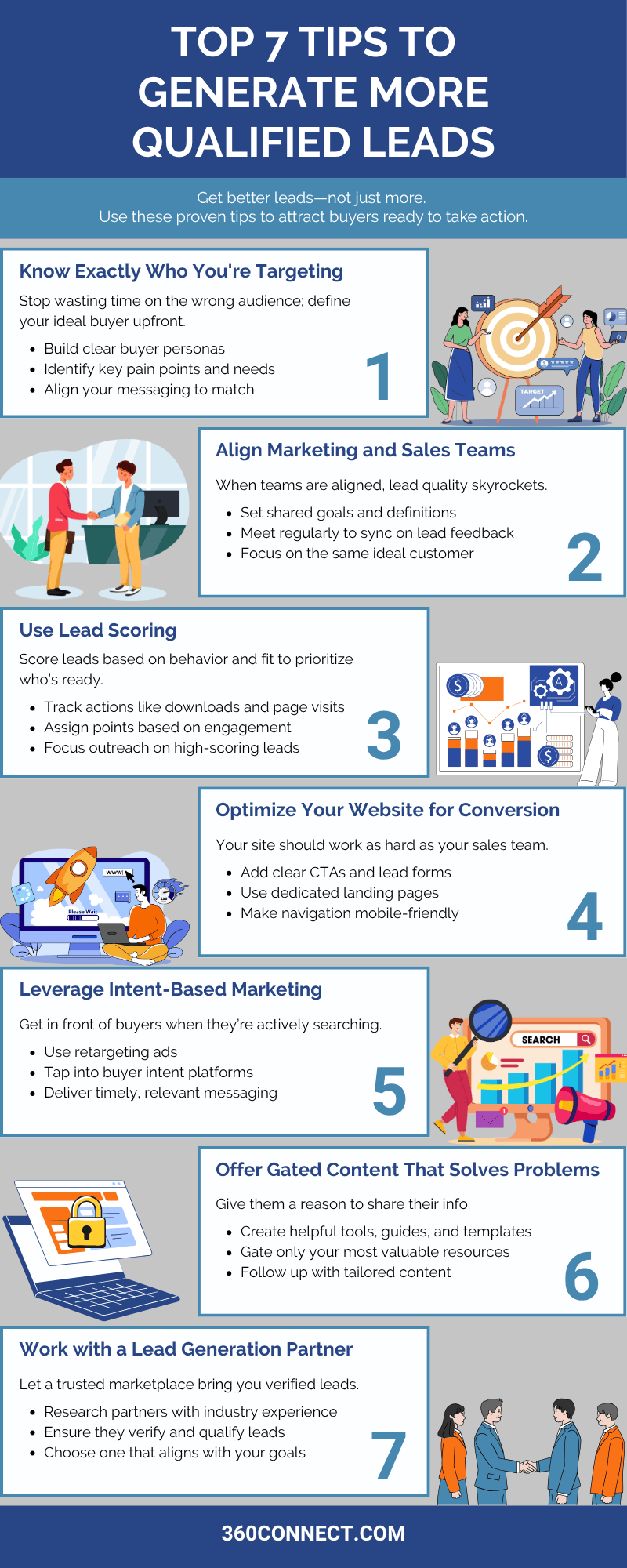Are you tired of generating leads that never result in sales? You’re not alone. A lot of B2B businesses run into this, and it’s not because they’re doing anything wrong. The real issue? They’re not generating qualified leads, the kind that are actually ready to buy.
The truth is, B2B companies have it especially tough when it comes to lead generation. There, we said it. And honestly, it feels good to say what we’re all thinking.
From longer sales cycles to smaller audiences to complex products and services… it’s hard enough getting leads in the first place. But getting qualified leads? That can feel overwhelming.
And that’s exactly why we put this blog together. If you’re stuck spinning your wheels or chasing the wrong prospects, this guide will walk you through how to attract the right people, the ones who actually want what you’re selling and are ready to talk business.
Let’s dive in.
What Are Qualified Leads?
Qualified leads are contacts who have shown genuine interest in your product, service, or solution, and are more likely to become paying customers. They’ve been screened or evaluated in some way, meaning they’re not just window shoppers. They’re potential buyers who are actively considering your solution.
Characteristics of a Qualified Lead
Every business may define “qualified” a little differently, but most qualified leads have:
- A clear need for your product or service
- The authority or influence to make purchasing decisions
- The budget and timeline to take action
Examples of Qualified Leads
To put it into context, a qualified lead might look like:
- Someone who filled out a contact form requesting a quote
- A decision-maker who downloaded a whitepaper and scheduled a demo
- A prospect who responded to a cold email with interest and relevant questions
During the lead generation process, these leads typically fall into one of two buckets: MQLs and SQLs. Let’s break those down.
Marketing Qualified Leads (MQLs)
An MQL is a lead who has engaged with your marketing efforts and seems likely to become a customer, just not quite yet. Think of MQLs as leads who’ve raised their hand but still need nurturing.
Examples of MQLs include:
- Someone who downloaded a gated asset
- A prospect who visited your pricing page multiple times
- A lead who engaged with your newsletter or webinar
MQLs aren’t ready to talk to sales just yet, but they’re worth investing in.
Sales Qualified Leads (SQLs)
SQLs have moved further down the funnel and are ready for direct outreach. These leads meet your sales team’s criteria and have indicated that they’re actively considering a purchase.
Examples of SQLs include:
- A prospect who submitted a request for a demo
- A lead who responded to a quote or proposal
- Someone who had a discovery call and shared their needs
These are the leads you want your sales team focused on because they’re primed to convert.
As you can see, not all leads are created equal, and knowing the difference between MQLs and SQLs helps you figure out who needs more nurturing and who’s ready to talk business. When you can spot qualified leads early on, your marketing and sales teams can spend less time guessing and more time closing.
Now let’s talk about why that matters.
Why Are Qualified Leads Important?
Let’s be honest, you’re not generating leads for fun. You want more customers, and qualified leads are how you get there. Focusing on quality over quantity helps your team work smarter, not harder.
Here’s why qualified leads matter in B2B:
- They shorten your sales cycle
- They increase your close rate
- They improve ROI from your marketing and sales efforts
Some eye-opening stats to back that up:
- 50% of marketers consider lead generation a top priority
- 79% say generating high-quality leads is their #1 focus
- 85% of B2B companies list lead generation as their most important marketing objective
Top 7 Tips to Generate More Qualified Leads
Alright, this is the part you came for. Let’s talk strategy. Below are seven proven ways to generate more qualified leads that your sales team will actually want to follow up with.

1. Know Exactly Who You’re Targeting
If you’re not clear on who you’re trying to reach, your messaging and outreach will miss the mark. Defining your ideal customer profile (ICP) and creating buyer personas helps you target the right audience from the start.
This includes understanding:
- Their job title and decision-making power
- Their pain points and goals
- Where they hang out (online and offline)
Takeaways:
- Start with a clear ICP
- Build detailed personas
- Align marketing and sales on who your ideal buyer is
2. Align Marketing and Sales Teams
Nothing kills lead quality faster than misalignment. Marketing might be focused on quantity, while sales wants leads that are ready to buy. Getting both teams on the same page can dramatically improve results.
Set shared goals, define MQL and SQL criteria together, and hold regular check-ins.
Takeaways:
- Set unified goals and definitions
- Communicate regularly across teams
- Use feedback loops to improve lead quality
Related: Aligning Sales and Marketing to Generate Quality Leads
3. Use Lead Scoring
Lead scoring helps prioritize your leads based on engagement, demographics, and behavior. The higher the score, the more likely they are to convert. This allows your team to focus on the hottest leads first.
Tools like HubSpot, Salesforce, and Zoho offer built-in lead-scoring features to help automate this.
Takeaways:
- Assign points based on actions and fit
- Prioritize follow-up based on score
- Continually refine your scoring model
4. Optimize Your Website for Conversion
Your website should be a lead generation machine, not a digital brochure. Make it easy for visitors to convert with clear CTAs, lead forms, and landing pages built around your offers.
And remember: speed, mobile-friendliness, and messaging clarity all impact performance.
Takeaways:
- Use strong CTAs and easy-to-fill forms
- Create landing pages tailored to specific audiences
- Track and test what’s working
5. Leverage Intent-Based Marketing
Meeting buyers at the moment they’re actively searching is powerful. Intent-based marketing uses behavior signals to target leads who are already showing interest in what you offer.
This includes:
- Retargeting website visitors
- Using buyer intent data platforms
- Showing ads to in-market prospects
Takeaways:
- Track user behavior to identify intent
- Serve content based on where they are in the journey
- Retarget based on past engagement
6. Offer Gated Content That Solves Problems
If you want leads, give them a reason to share their info. Gated content like guides, checklists, calculators, or templates can generate high-quality leads, especially when it’s genuinely helpful.
Just make sure what you’re offering is worth the form fill.
Takeaways:
- Create content based on buyer needs
- Gate only your most valuable resources
- Follow up with relevant nurturing content
7. Work with a Lead Generation Partner
Sometimes, the best way to get more qualified leads is to let the pros handle it. Lead generation companies can help you get matched with buyers who are already looking for your solution, saving you time and energy.
Just be sure the partner you choose uses verified leads and supports your sales goals.
Takeaways:
- Choose a partner with industry experience
- Ask about lead quality standards
- Look for verified, in-market buyer connections
3 Steps to Get More Qualified Leads
Okay, you’ve got the tips. Now here’s how to actually put them into play. These are the practical next steps to start attracting leads that are actually ready to buy.
1. Build a Lead Qualification Checklist
Start by creating a simple, repeatable process for identifying high-quality leads. This should include things like budget, timeline, authority, and need. The clearer your checklist, the easier it’ll be for your team to focus on the right prospects.
- Define what makes a lead “qualified” for your business
- Share the checklist with both marketing and sales
- Use it to assess all new leads consistently
2. Set Up Your Lead Tracking System
Whether it’s a CRM or a spreadsheet, you need a place to capture and evaluate leads. Make sure your system includes key data points that align with your qualification checklist, and assign someone to monitor it regularly.
- Use a CRM or lead management tool
- Track engagement, source, and next steps
- Score leads based on fit and behavior
3. Explore Lead Sources That Fit Your Industry
Not all lead sources are created equal. Research online marketplaces, niche directories, and platforms that specialize in your specific industry. The more aligned the platform is with your audience, the more qualified your leads will be.
- Research online marketplaces and supplier networks
- Look for platforms that serve your exact industry
- Start with one or two to test quality before scaling
Top 10 Sources for Finding Qualified Leads
Now that you’ve got a strategy, here are 10 great places to actually find those leads:
- Your website and landing pages
- LinkedIn (organic and paid)
- Email marketing campaigns
- Search engine ads (Google, Bing)
- Content marketing (blogs, SEO)
- Webinars and virtual events
- Cold outreach with smart targeting
- Industry trade shows and networking events
- Referrals from customers or partners
- Lead generation marketplaces
Final Thoughts on How to Generate More Qualified Leads
When it comes to B2B, getting qualified leads isn’t about luck, it’s about strategy. It takes patience, alignment, and a deep understanding of your audience. But when you get it right? You close more deals, spend less time chasing bad prospects, and grow your business with confidence.
Get Qualified Leads Daily
At 360Connect, we connect B2B suppliers with verified, high-intent buyers actively searching for your product or service. If you’re ready to start seeing better leads and better results, we’re ready to help.

